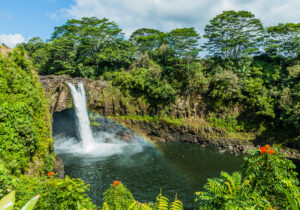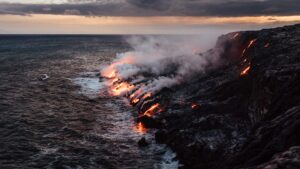Elizabeth Preske reports for Travel and Leisure on 15 active volcanoes you can hike. Four of our luxury tours include the Kilauea Volcano which is on this list.
Over hundreds of thousands of years, volcanic activity has yielded a breathtaking array of breathtaking features, from craters and calderas to lava flows and lava tubes.
And these features aren’t just terms from your elementary school science textbook: You can actually see them up close. All you have to do is hike an active volcano.
To help you get started planning your next adventure, we’ve rounded up 15 hikeable volcanoes around the world that draw thrill-seekers, nature enthusiasts, and mountain climbing experts to their awe-inspiring peaks. A few are easily accessible to beginner hikers, while some require gear, technical climbing skills, high levels of fitness, and a fair bit of courage to reach the summit. And plenty of others offer a variety of spectacular trails in between the extremes.
But no matter which volcano you plan to hike – whether it’s consistently quiet or continuously erupting – make sure you’re up to speed on its alert levels before you leave for your trip, as trails may be temporarily closed due to strong gases, eruptions, and other volcanic activity.
Mount Etna
Outside Italy’s Catania sits the nearly 11,000-foot-tall Mount Etna, Europe’s largest active volcano. Not only has Mount Etna been erupting longer than any other volcano in written history (its first was recorded in 425 B.C.), it also erupts more frequently than most in the world.
Despite its high activity, Mount Etna is fairly safe for nearby residents. To visit, drive or take a bus from Catania’s railway station to the parking lot at Rifugio Sapienza. You will then take a cable car to the station on Mount Etna; once you’re there, you can hike along any number of trails to the top.
Pacaya
Pacaya is roughly a two-hour drive from Antigua and is only possible to climb with a guide. You can hire one at the visitor’s center, or you can join a guided tour that leaves from Antigua. If the moderately steep hike seems too arduous, you also have the option to ride a horse to the top for 300 Quetzal (about $40). Don’t forget to pack chocolate and graham crackers for the hike: Your guide will be handing you marshmallows to roast on the fumaroles.
Mount Aso
At the center of Kyusho, Japan’s third largest island, lies Mount Aso. Its caldera is one of the largest in the world, with a 16-mile diameter and an 80-mile circumference. Five volcanic peaks can be found in the caldera; one of them, Mount Nakadake, is an active volcano that has a summit reaching 4,900 feet.
You can reach the Nakadake Crater by taking a bus from JR Aso Station in Aso, Kumamoto, Japan to Asosan Nishi Station. The Ropeway service from the station to the crater is currently suspended, but it’s only a 30-minute walk to get there. On the other hand, you can also drive to a parking lot next to the crater (but be prepared to pay a toll on the way).
While you’re visiting Aso-Kuju National Park, be sure to check out the Aso Volcano Museum by the Nakadake Crater, as well as the nearby hot spring villages in Tarutama, Jigoku, and Aso. And if you’re itching to get more hiking in, Mount Aso’s other four peaks offer plenty of trails.
Mount Mayon
The most active volcano in the Philippines, Mount Mayon has erupted approximately 50 times since the 1600s, most recently in January 2018. The trek up the mountain isn’t easy, with Trail Adventours ranking it a seven out of 10 in “trail difficulty” for the two-day journey (although you may wish to tack on an extra day). If you’re up for the task, head on over to Legaspi in Albay Province; from there, you can take the BUYUHAN trail in Buyahan or the BUANG trail in Tabaco.
Mount St. Helens
You don’t have to leave the country to hike a volcano. This 8,300-foot volcano in Washington state offers more than 200 miles of trails, where you’ll find a wide variety of scenic points of interest among the rock and ash, including gorgeous waterfalls, lakes, and canyons, an emerging glacier, and otherworldly caves. There are trails for hikers of all skill levels, from the stroller and wheelchair-friendly Meta Lake loop to the 28-mile Loowit Trail. The hike to the summit is no easy feat, but as long as you have a permit, it’s well within your reach – no technical skills required.
Mount Ngahuruohe
“Lord of the Rings” fans will recognize this volcano as Mount Doom from the famous Tolkien franchise, but luckily you don’t have to navigate your way to Middle-earth to see its real-life counterpart. Located in Tongariro National Park, the oldest national park in New Zealand and a UNESCO dual World Heritage Area, Mount Ngauruhoe can be reached by hiking the Tongariro Alpine Crossing.
Billed as one of New Zealand’s best day hikes, this one-way 12-mile hike takes you through a volcanic landscape of crater lakes, glacial valleys, and ancient lava flows. The Tongariro Crossing itself can be done in seven to eight hours, but plan to spend an additional three hours for a rocky – and steep – side trip to Ngaurohoe’s summit.
Mount Vesuvius
Perhaps the most famous of Italy’s volcanoes is Mount Vesuvius, notorious for destroying Pompeii and Herculaneum in A.D. 79. Mount Vesuvius is mainland Europe’s only active volcano, and despite having only erupted three dozen times, its close proximity to Naples also makes it one of the world’s most dangerous.
Vesuvius National Park offers nine different trails for beginners and advanced hikers. According to ITALY Magazine, while Trail 5 – the hike to the Gran Cono (Big Cone) – is the most popular, you can get the best views of the park by opting for the more manageable Trail 4. Head to the official website for directions to Vesuvius.
Masaya Volcano
Masaya Volcano is one of two volcanoes within Masaya Volcano National Park, its highest peak reaching 2,000 feet above sea level. What makes this volcano extra-special is the one-of-a-kind night tour: for $10, you can drive up to the crater in the evening and peer into the glowing and bubbling depths of its lava lake.
Since you only get 15 minutes at the crater, consider going back during the day. Many of the hiking trails are indefinitely closed, but the Plaza de Oviedo is still open to the public for unique views of the Santiago crater and Cruz de Bobadilla.
Mount Rinjani
The second highest volcano in Indonesia, the 12,200-foot Mount Rinjani can be found in Gunung Rinjani National Park. Few make it to the summit, but you can take a two-day trip to the crater rim to see Segara Anak, the volcano’s awe-inspiring and sacred crater lake; Aik Kalak, its natural hot spring; and Mount Barujari, the crater’s active “baby” volcano.
To embark on this historically spiritual journey, head to either one of two access points: Senaru or Sembalun Lawang on the Indonesian island of Lombok. The government discourages hikers from climbing the mountain without a guide, so signing up for an organized trek is your best option.
Arenal
This 5,400-foot volcano can be found in the rainforest landscape of Costa Rica’s Arenal Volcano National Park. Arenal hasn’t spewed lava since 2010, but you can still hear it rumble while it puffs and smokes.
It’s illegal to hike Arenal (as well as the park’s other volcano, the dormant Cerro Chato), but there are lots of trails in the park to keep you occupied, many of which are short, flat, and perfect for novice hikers. For unparalleled views of Arenal Volcano and Lake Arenal, take the Colades de Lava trail, which goes through scenic secondary forests and lava fields. And while the park isn’t known for its wildlife, see if you can spot parrots and toucans among the trees.
Hawai’I Volcanoes National Park
Months after Kīlauea infamously erupted in May 2018, Hawai’i Volcanoes National Park has reopened to the public. While you will no longer be able to see the park’s iconic lava lake inside Halema’uma’u Crater, or the lava flowing out of Pu’u ‘Ō’ō Crater, several key attractions and trails remain ripe for exploration.
The famed Crater Rim Trail, for one, can be taken from Volcano House to Kīlauea Military Camp, as well as from Chain of Craters Road to Escape Road. Although sections of the Crater Rim Drive have been closed, pedestrians and cyclists are still able to navigate the trail from Chain of Craters Road to Keanakāko’i Crater. The Kīlauea Iki Overlook, Devastation Trail, and the Sulphur Banks Trail also make this national park one for the bucket list.
Villarrica
Villarrica is one of Chile’s most active volcanoes, as well as one of the only volcanoes in the world to have a lava lake in its crater. Unless you’re a mountaineering expert, you’ll need a guide and equipment to hike this behemoth. Guided tours leave from Pucón, and when you get to the mountain, you can save yourself an hour and a half of hiking by taking the $30 chairlift. While a snowy, icy hike may sound a bit daunting, the exhilarating sled ride down the slopes should be enough to motivate you (and ease your fears about how you’re going to get back down).
Eyjafjallajokull
Reykjavík, Blue Lagoon, and Thingvellir National Park might spring to mind when you think of Iceland, but the tourist hotspot is also home to the volcano Eyjafjallajökull, whose May 2010 eruption infamously halted flights across Europe for nearly a week.
It’s a dangerous hike to Eyjafjallajökull’s 5,500-foot summit, so you may want to consider booking a guided tour for the four-mile trek. Rather than climb to the top, you could alternatively take the 15-mile Fimmvörðuháls trail, which is thought to be one of the best day hikes in the country. With stunning views of waterfalls, rivers, and lava fields amid the dramatic backdrop of Eyjafjallajökull and the glacier Mýrdalsjökull, it’s easy to see why.
Cotopaxi
Cotopaxi is the third most active volcano in the world, in addition to being – at 19,300 feet – the second highest mountain in Ecuador. Located outside of Quito in the Andes Mountains, you may want to hire an accredited mountain guide if you want to hike to the icy summit.
But you don’t have to hike the volcano to enjoy the rest of Cotopaxi National Park: you can also take the slightly less strenuous trail to the Jose Ribas Refuge, or opt for the peaceful, nature-filled path around the lake, Laguna Limpiopungo.
Whakaari/White Island
More commonly known as White Island, New Zealand’s only active marine volcano can be found in the country’s Bay of Plenty. As only 10% of the volcano is visible above the sea, you can easily see the crater without having to hike up steep trails.
To get to the island, you’ll have to sign up for a guided tour. Once there, your guide will take you across a colorful lunar topography on your way to the crater lake, crater, and the remains of a sulfur factory for Instagram-worthy snaps.




